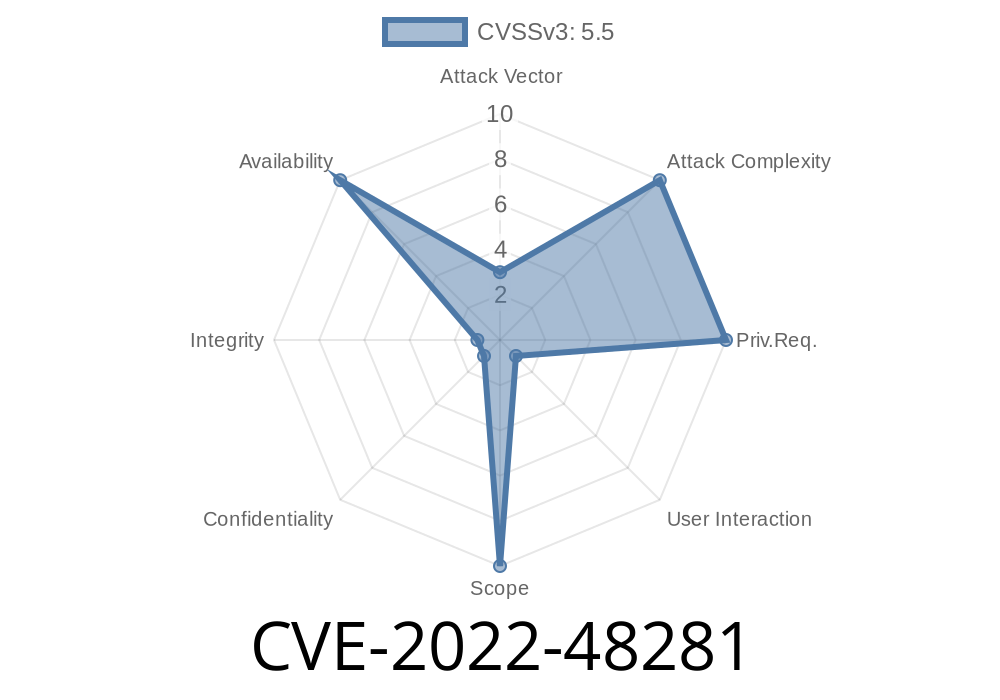A new vulnerability has been discovered in the LibTIFF library that could lead to a heap-based buffer overflow, potentially causing an application to crash or allowing arbitrary code execution by an attacker. Dubbed CVE-2022-48281, this specific vulnerability resides in the processCropSelections function in tools/tiffcrop.c of LibTIFF through version 4.5.. This post will discuss the details of this vulnerability, including an explanation of the affected code, potential attack scenarios, and links to original references.
Code Snippet
The processCropSelections function in tools/tiffcrop.c is responsible for cropping selected regions from a TIFF image. The vulnerability arises due to improper bounds checking when handling TIFF images with a large number of strips. Here's an excerpt from the vulnerable code:
/* processCropSelections is defined in tools/tiffcrop.c */
static void
processCropSelections(TIFF* in, TIFF* out, struct crop_mask* crop, struct pagedef* page)
{
// ...
for (uint32 row = ; row < length; row += delta_y) {
// ...
for (uint32 col = ; col < width; col += delta_x) {
// ...
memcpy(cpRaster + (span * width + col), cpBuf + span * width, span * sizeof(uint32));
}
}
}
The memcpy operation highlighted above is where the heap-based buffer overflow occurs. When processing a crafted TIFF image with a large number of strips, it may result in a memory write operation with a size larger than the allocated heap buffer for cpRaster or cpBuf, causing a buffer overflow.
Original References
The details of this vulnerability can be found in the official CVE entry, along with any additional references and clarifications:
- CVE-2022-48281 - NVD - National Vulnerability Database
- LibTIFF Homepage
- LibTIFF Vulnerabilities - oss-security
- Commit Fixing the Vulnerability
Corrupting memory, potentially leading to arbitrary code execution
To exploit the vulnerability, an attacker would typically create a malicious TIFF image containing a large number of strips, then persuade a target to open or process the image using an application that uses the affected version of the LibTIFF library. When the application processes the crafted image through the processCropSelections function, it may trigger the heap-based buffer overflow, allowing the attacker to execute arbitrary code and take control of the system.
Mitigation
It is essential to update the LibTIFF library to the latest version, which includes patches to address this specific vulnerability. If you are using third-party applications that rely on the LibTIFF library, it is crucial to update those applications to the latest versions incorporating the corrected library.
For developers using the LibTIFF library in their projects, it is critical to ensure proper bounds checking when working with TIFF images, particularly when handling memory allocation and copying functions. Additionally, employing secure coding practices and following the principle of least privilege can help minimize the effects of potential future vulnerabilities.
Conclusion
CVE-2022-48281 highlights the importance of secure coding practices and timely software updates. The heap-based buffer overflow vulnerability in processCropSelections can have severe consequences if exploited, allowing an attacker to execute arbitrary code and take control of a target system. It is vital for developers and users alike to understand the risks posed by this type of vulnerability and to ensure that their systems and applications are updated to the latest, patched versions of the LibTIFF library.
Timeline
Published on: 01/23/2023 03:15:00 UTC
Last modified on: 03/02/2023 16:15:00 UTC
